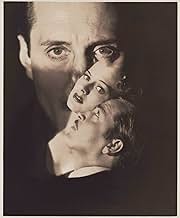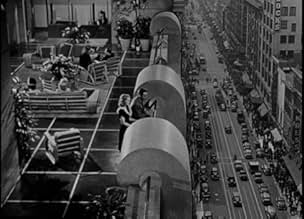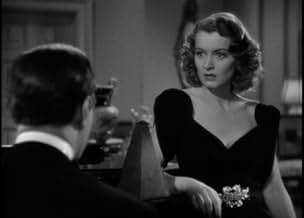Aggiungi una trama nella tua linguaA crazed physician marries a wealthy women and, with the help of his demented assistant, murders them for their money.A crazed physician marries a wealthy women and, with the help of his demented assistant, murders them for their money.A crazed physician marries a wealthy women and, with the help of his demented assistant, murders them for their money.
- Regia
- Sceneggiatura
- Star
Barbara Jo Allen
- Louise Watkins
- (as Barbara Allen [Vera Vague])
Bobby Barber
- Bald Man in Library
- (non citato nei titoli originali)
William 'Billy' Benedict
- Mickey Barnes - Copy Boy
- (non citato nei titoli originali)
George Chandler
- Elevator Operator
- (non citato nei titoli originali)
Edward Earle
- Librarian
- (non citato nei titoli originali)
Chuck Hamilton
- Police Officer at Train Station
- (non citato nei titoli originali)
Sam Harris
- Passerby
- (non citato nei titoli originali)
Harry Hayden
- Ticket Clerk
- (non citato nei titoli originali)
Douglas Kennedy
- Hotel Clerk
- (non citato nei titoli originali)
Settar Körmükçü
- Dr. David Profesor
- (non citato nei titoli originali)
John Laing
- Intern
- (non citato nei titoli originali)
Recensioni in evidenza
Doctor Ralph Morgan calls at Basil Rathbone's home. His patient, Rathbone's wife, has died. Morgan is suspicious; she was recovering. He does nothing about it.
His suspicions are justified. Rathbone speaks with his manservant, Martin Kosleck, of how much he despised his rich wife and her stupid town, just like his other victims. They will return to New York, and he to his practice as a psychiatrist. There he is hired to deal with Ellen Drew, a depressed and suicidal socialite whose newspaper boyfriend, John Howard, has his suspicions. His investigations lead him to Morgan, even as Miss Drew marries Rathbone.
Rathbone offers his usual graceful performance as a man struggling with redemption. Most noteworthy of all, however, is Ellen Drew's performance as someone suicidal when we first meet her, to someone lighthearted after the ordinary pleasures of Coney Island. Alas, there is no sign of revival of her psychoses at the end, but in that era, endings had to be happy, even in a movie that focuses on Rathbone's attempts to deal with his own dark desires.
Hecht and MacArthur did uncredited work on the script, and they undoubtedly gave the producers what they asked for; neither was director Tim Whelan the man to stand up for a darker vision; he had returned to the US doing work on Korda's THE THIEF OF BAGDAD, and this was his first movie after that. It was no time to antagonize the brass at Paramount.
His suspicions are justified. Rathbone speaks with his manservant, Martin Kosleck, of how much he despised his rich wife and her stupid town, just like his other victims. They will return to New York, and he to his practice as a psychiatrist. There he is hired to deal with Ellen Drew, a depressed and suicidal socialite whose newspaper boyfriend, John Howard, has his suspicions. His investigations lead him to Morgan, even as Miss Drew marries Rathbone.
Rathbone offers his usual graceful performance as a man struggling with redemption. Most noteworthy of all, however, is Ellen Drew's performance as someone suicidal when we first meet her, to someone lighthearted after the ordinary pleasures of Coney Island. Alas, there is no sign of revival of her psychoses at the end, but in that era, endings had to be happy, even in a movie that focuses on Rathbone's attempts to deal with his own dark desires.
Hecht and MacArthur did uncredited work on the script, and they undoubtedly gave the producers what they asked for; neither was director Tim Whelan the man to stand up for a darker vision; he had returned to the US doing work on Korda's THE THIEF OF BAGDAD, and this was his first movie after that. It was no time to antagonize the brass at Paramount.
"Oh, there's no such thing as sanity. At it's best a heroic and precarious little hiding place in which we try to conceal ourselves from the devils...The devils of time, space, things unknown, and the past."
Although its title suggests conventional horror, "The Mad Doctor" is a pitch black thriller with some with some truly harrowing subject matter. Basil Rathbone plays Dr. Sebastien, a Bluebeard-like psychiatrist who recently killed off his wealthy wife Ida. After arousing the suspicion of local doctor Ralph Morgan, Rathbone leaves town. He soon finds his next mark, a deeply troubled young socialite named Linda that's been suffering with suicidal ideations.
Rathbone is accompanied in his efforts by Martin Kosleck as Maurice, a sort of male secretary. After seeing these two interact, it becomes very clear that they are more than criminal accomplices. When we see Kosleck in Rathbone's home or office, he's variously arranging flowers, spritzing himself with cologne, fussing with Rathbone over a choice of tie, and languorously sketching a black cat while wearing a bathrobe. When Rathbone starts to become genuinely interested in Linda, Kosleck responds with wounded jealousy.
This is very obviously a coded gay relationship, years ahead of the one in Hitchcock's "Rope." The scenes between Rathbone and Kosleck, both superb actors, positively crackle. In one scene, Rathbone gives a bone chilling monologue describing his contempt for dead wife Ida: "These atrocious paintings. This absurd wallpaper. These pathetic antiques. They all breathe her spirit. I can almost see her now coming down those stairs with that foolish smile and the love light in her eyes. I can never forgive her the eight months spent in this cave of romance."
The danger and intensity only ratchet up from there, climaxing in a truly haunting and beautifully executed ending. This is one of Basil Rathbone's most underrated films.
Although its title suggests conventional horror, "The Mad Doctor" is a pitch black thriller with some with some truly harrowing subject matter. Basil Rathbone plays Dr. Sebastien, a Bluebeard-like psychiatrist who recently killed off his wealthy wife Ida. After arousing the suspicion of local doctor Ralph Morgan, Rathbone leaves town. He soon finds his next mark, a deeply troubled young socialite named Linda that's been suffering with suicidal ideations.
Rathbone is accompanied in his efforts by Martin Kosleck as Maurice, a sort of male secretary. After seeing these two interact, it becomes very clear that they are more than criminal accomplices. When we see Kosleck in Rathbone's home or office, he's variously arranging flowers, spritzing himself with cologne, fussing with Rathbone over a choice of tie, and languorously sketching a black cat while wearing a bathrobe. When Rathbone starts to become genuinely interested in Linda, Kosleck responds with wounded jealousy.
This is very obviously a coded gay relationship, years ahead of the one in Hitchcock's "Rope." The scenes between Rathbone and Kosleck, both superb actors, positively crackle. In one scene, Rathbone gives a bone chilling monologue describing his contempt for dead wife Ida: "These atrocious paintings. This absurd wallpaper. These pathetic antiques. They all breathe her spirit. I can almost see her now coming down those stairs with that foolish smile and the love light in her eyes. I can never forgive her the eight months spent in this cave of romance."
The danger and intensity only ratchet up from there, climaxing in a truly haunting and beautifully executed ending. This is one of Basil Rathbone's most underrated films.
Strangely lacklustre reviews to this quite novel 1940 Noir. Insightful, knowledgeable scripting, wonderful schwartz photography from Ted Tetzlaff. A sinister Rathbone undulating between predator and smitten, with both his male accomplice and the full lips of Ellen Drew on the way to more resolute acting ahead. The opening 10 minute rainstorm introduces the maelstrom perfectly and it continues at a good pace, with a variety of well edited sequences adding to the narrative flow, the high night time shots above 5th Avenue conjured well by subtle SFX. The ubiquitous Ben Hecht had a hand in the screenplay, alongside Harold J. Green, and it shows in this robust, ballsy psycho-drama.
1940's "The Mad Doctor" is a sadly generic but wholly appropriate title for this Paramount feature, one of their rare genre efforts (working titles "The Monster" and "A Date with Destiny"). In the title role of Dr. George Sebastian, Basil Rathbone is not a 'mad doctor' as in 'mad scientist,' but a psychotic faux psychiatrist living with partner Maurice Gretz (Martin Kosleck), both wanted for murder in Vienna, having relocated to America. With the sudden demise of Sebastian's third wife, he takes up residence in New York City, where he begins another practice, meeting up with potential wife number four, hypochondriac Linda Boothe (Ellen Drew), whom Maurice believes would be the perfect candidate due to her suicidal tendencies (that would save them the trouble of bumping her off). Lurking in the background is Dr. Charles Downer (Ralph Morgan), a longtime friend of Sebastian's late wife, whose suspicions about her untimely death are soon confirmed, at his peril. This Ben Hecht story is loaded with promise, yet fudges its attempts at suspense with sketchy characterizations, virtually none of whom engender any sympathy, particularly the heroine, apparently as dim as the scatterbrained sister (Barbara Allen) that introduced her to Dr. Sebastian. The binding relationship between the doctor and Maurice is by far the most intriguing aspect to the film, but little footage is devoted to their villainy, the pace slowed to a crawl by endless romantic twaddle. The final third almost makes up for all these faults, but the excellent cast is left pretty much on their own. Ellen Drew was much better, and far more sympathetic, in another Paramount, "The Monster and the Girl," while Martin Kosleck easily steals his scenes from the rather surprisingly uninspired Rathbone (much better in "Kind Lady"), soon to enjoy one of his finest villains opposite Tyrone Power in "The Mark of Zorro."
Basil Rathbone stars with Ellen Drew in The Mad Doctor from 1940.
Rathbone plays a psychiatrist, George Sebastien, who is a black widower, marrying women for their money and then killing them. The last time, the doctor in charge of his wife's case (Ralph Morgan) is suspicious, but Sebastien convinces his assistant (Martin Kosleck) that the old man is harmless. As usual, they pick up stakes, this time moving to New York City.
Sebastien becomes aware of a beautiful young woman, Linda Boothe (Drew) who is depressed and suicidal. He agrees to take her case.
Her boyfriend (John Howard) doesn't believe in psychiatry and wants to discredit him. As a reporter, he writes a series of negative articles.
The problem here is that Howard takes such an instant dislike to the doctor that it just comes off as jealousy. However, Sebastien does get to the reason for Linda's problems - her own father's suicide - and helps her.
Sebastien has actually fallen for Linda and believes he has been cured of his desire to kill. That apparently arose from his first wife cheating on him.
This is a very entertaining if strange film. One wonders about the relationship between Sebastien and his assistant, who is furious that Sebastien wants to marry Linda and stop killing.
Rathbone is terrific - romantic, charming, and evil. Drew is a lovely actress and ideal in her role. Martin Kosleck as the bizarre assistant is just right.
Recommended. Rathbone is always good.
Rathbone plays a psychiatrist, George Sebastien, who is a black widower, marrying women for their money and then killing them. The last time, the doctor in charge of his wife's case (Ralph Morgan) is suspicious, but Sebastien convinces his assistant (Martin Kosleck) that the old man is harmless. As usual, they pick up stakes, this time moving to New York City.
Sebastien becomes aware of a beautiful young woman, Linda Boothe (Drew) who is depressed and suicidal. He agrees to take her case.
Her boyfriend (John Howard) doesn't believe in psychiatry and wants to discredit him. As a reporter, he writes a series of negative articles.
The problem here is that Howard takes such an instant dislike to the doctor that it just comes off as jealousy. However, Sebastien does get to the reason for Linda's problems - her own father's suicide - and helps her.
Sebastien has actually fallen for Linda and believes he has been cured of his desire to kill. That apparently arose from his first wife cheating on him.
This is a very entertaining if strange film. One wonders about the relationship between Sebastien and his assistant, who is furious that Sebastien wants to marry Linda and stop killing.
Rathbone is terrific - romantic, charming, and evil. Drew is a lovely actress and ideal in her role. Martin Kosleck as the bizarre assistant is just right.
Recommended. Rathbone is always good.
Lo sapevi?
- QuizOne of over 700 Paramount Productions, filmed between 1929 and 1949, which were sold to MCA/Universal in 1958 for television distribution, and have been owned and controlled by Universal ever since; its earliest documented telecast took place in Seattle Monday 11 May 1959 on KIRO (Channel 7).
- BlooperAt the Library, Sebastien shades over a page with a pencil to see the impression of what was written there earlier but when he tears the page off the pad, the page is untouched.
- Citazioni
Maurice Gretz: You're like all the other clever ones, clever until they meet a woman, and then they suddenly become fools.
- ConnessioniReferenced in Svengoolie: Night Monster (2015)
- Colonne sonoreAloha 'Oe
Music by Queen Liliuokalani
I più visti
Accedi per valutare e creare un elenco di titoli salvati per ottenere consigli personalizzati
- How long is The Mad Doctor?Powered by Alexa
Dettagli
- Data di uscita
- Paese di origine
- Lingua
- Celebre anche come
- La cita fatal
- Luoghi delle riprese
- Azienda produttrice
- Vedi altri crediti dell’azienda su IMDbPro
- Tempo di esecuzione1 ora 30 minuti
- Colore
- Proporzioni
- 1.37 : 1
Contribuisci a questa pagina
Suggerisci una modifica o aggiungi i contenuti mancanti

Divario superiore
By what name was The Mad Doctor (1940) officially released in India in English?
Rispondi


































